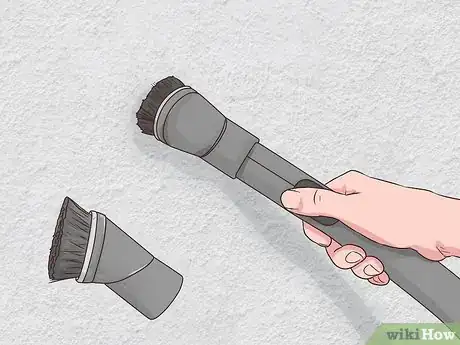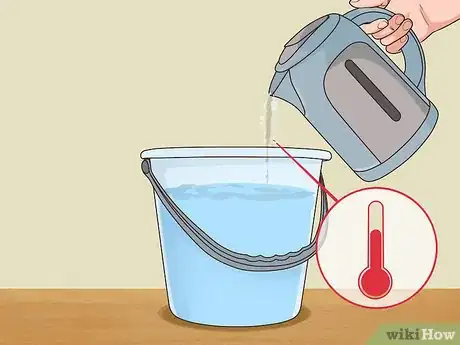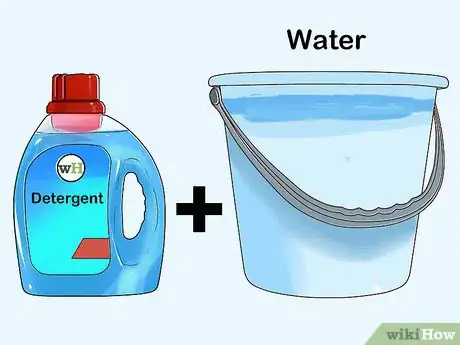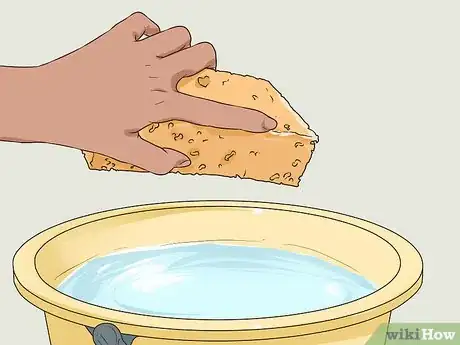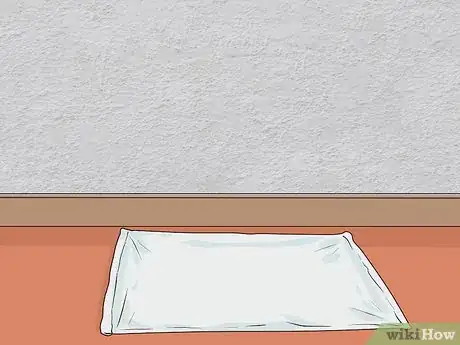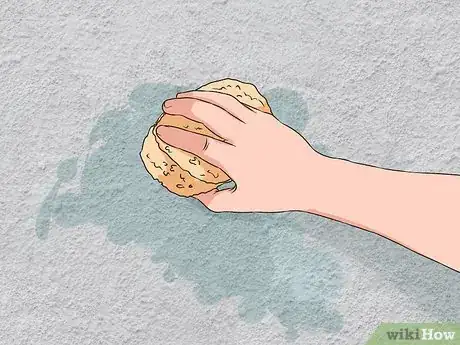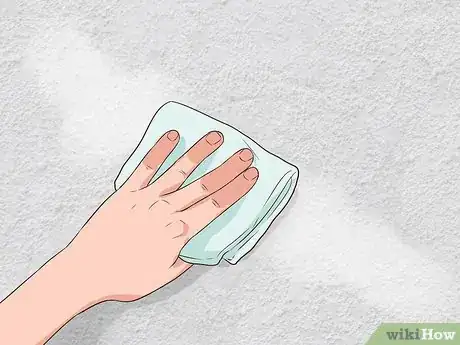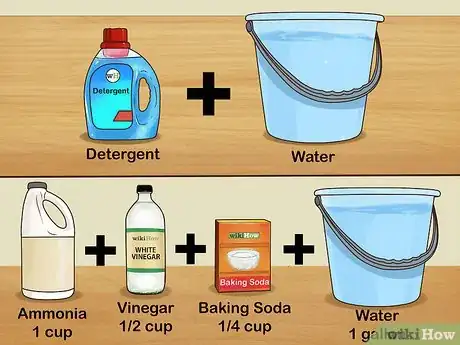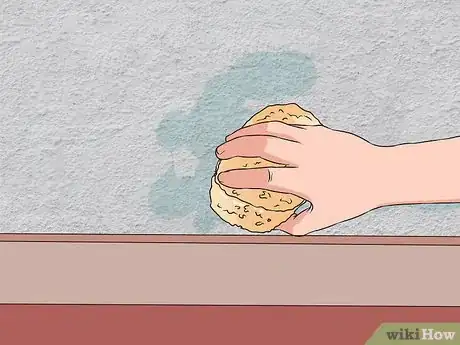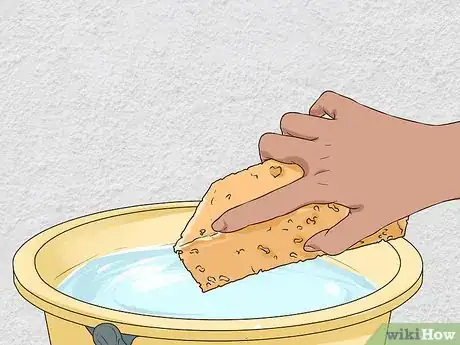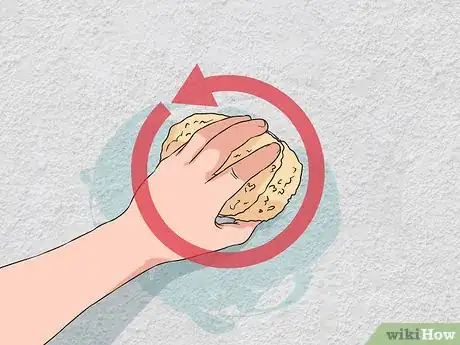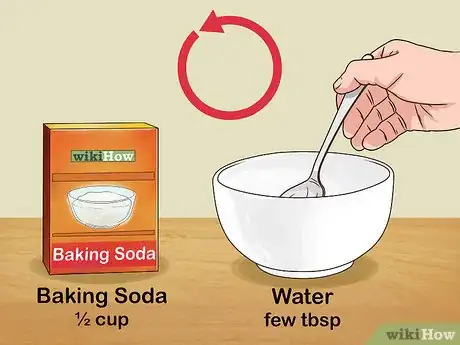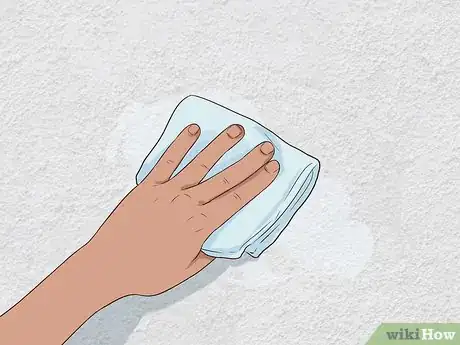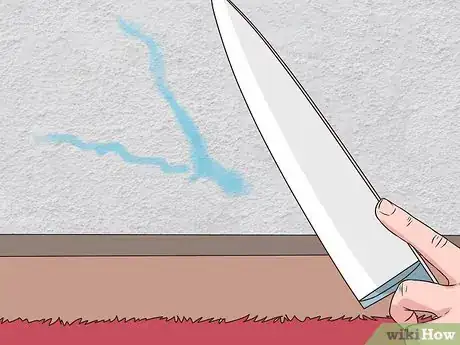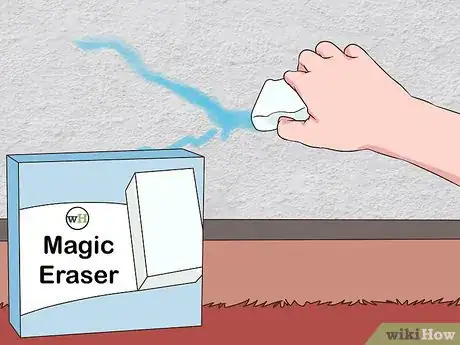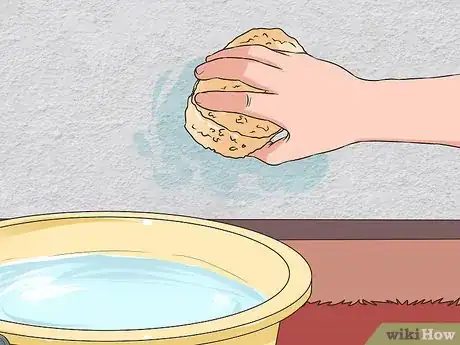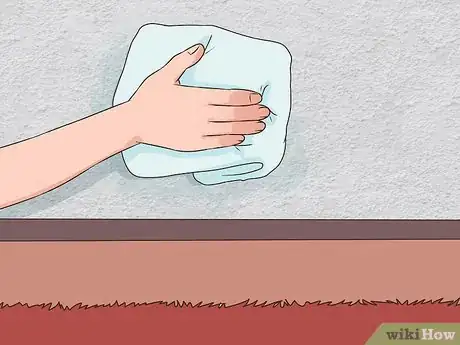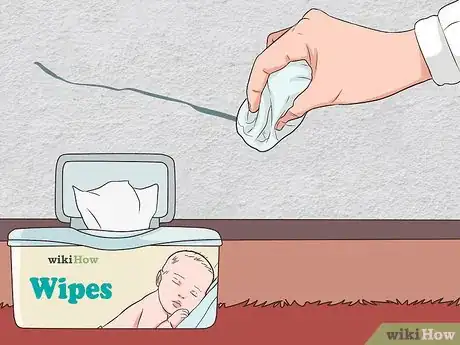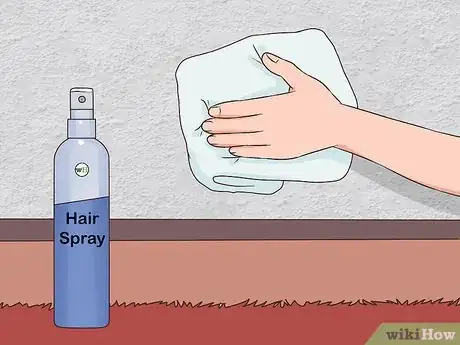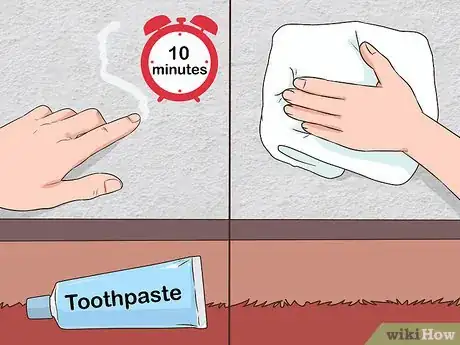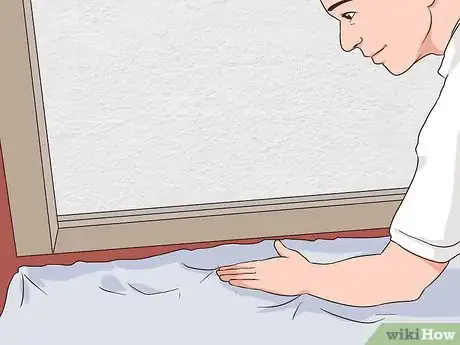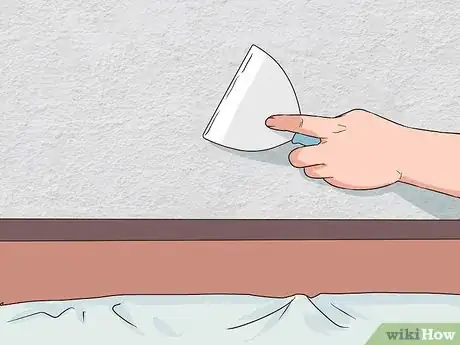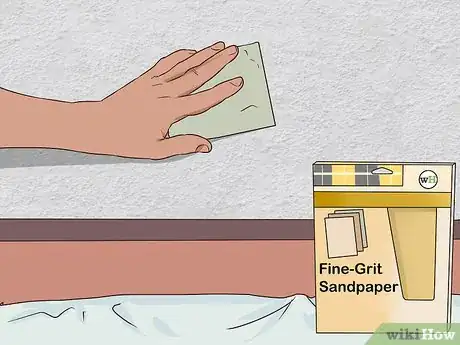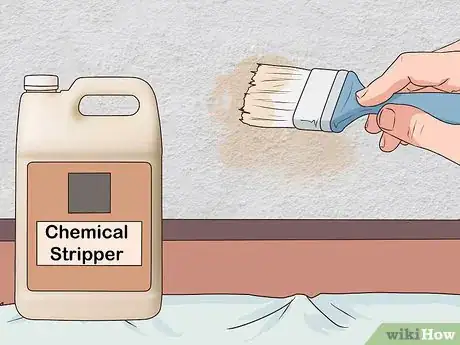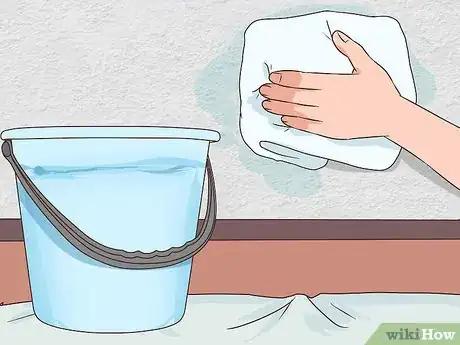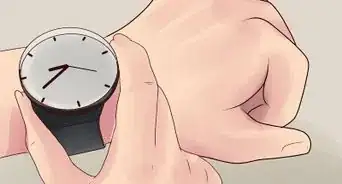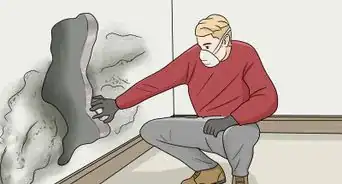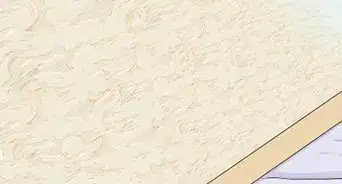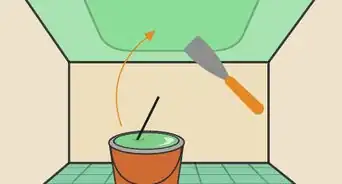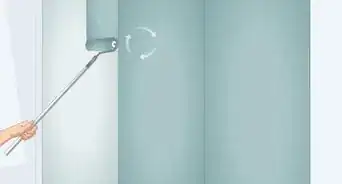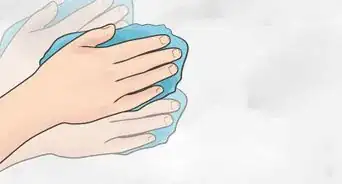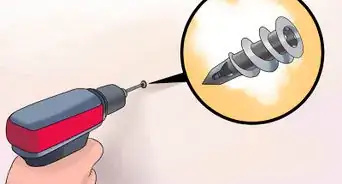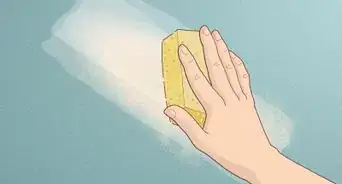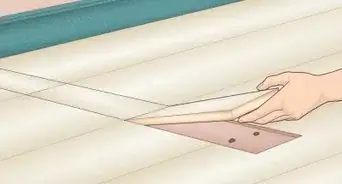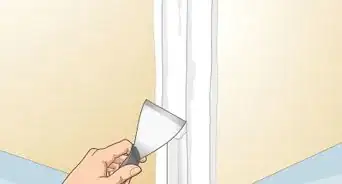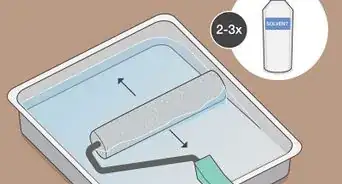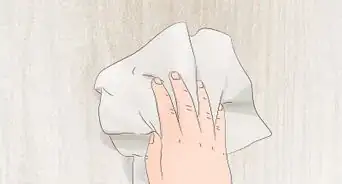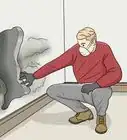This article was co-authored by Daniel Olin. Daniel Olin is a Home Cleaning Specialist and the CEO of Easyway Maid Service, a home-cleaning company based in Austin, Texas. With over four years of experience, Daniel and Easyway Maid Service specialize in executive-quality maid service, as well as vacation rental cleaning and overall home deep cleaning. Daniel holds a BA in Psychology from The University of California, Los Angeles.
This article has been viewed 99,266 times.
Plaster is a common and versatile construction material. Cleaning a plaster wall is not radically different than cleaning other types of walls. Your principal concern when cleaning the wall should be protecting the paint job unless you are trying to remove the paint itself. When removing paint, the porous texture of plaster walls does require that you be more gentle than with some other surfaces.
Things You Should Know
- Wipe down the wall with warm water and a soft sponge for a light cleaning.
- To handle stains, add mild detergent to the warm water. Dunk your sponge in the solution and wipe the stained area using circular motions.
- If the stain persists, apply hairspray to the stained area. Then, wipe the wall with a paper towel using gentle, circular motions.
Steps
Performing a Light Cleaning
-
1Use the dust brush attachment on your vacuum. Attach the dust brush to the end of your vacuum and run the vacuum over the wall. This is the least abrasive way to clean walls and should always be your first step. If you find that your walls are sufficiently clean after using the vacuum, you should stop after performing this step.[1]
- Do not put pressure on the wall as you vacuum it. Lightly rub the vacuum over it and allow the suction to pick up dirt.[2]
- Pick a section of the wall. Start at the top and move the vacuum from side to side, then down, until you reach the floor. When you reach the floor, move on to the next section. Use a ladder if you cannot reach the ceiling.
- Empty the vacuum cleaner before beginning this process.
-
2Fill a bucket with warm water. Keep the pail of water near you while you clean so you do not need to make constant trips to the sink. As you clean, regularly squeeze dirty water out of the sponge and wet it again in the bucket of clean water.[3]Advertisement
-
3Consider adding detergent to the water. A small amount of detergent can also be thrown into the water, just enough to create a few bubbles. However, this creates the danger of damage to your paint job. Consider starting without detergent. Add detergent if warm water does not seem to be sufficient for cleaning the wall. You should begin the cleaning process with the least abrasive cleaner available and then work up to more abrasive cleaners only if necessary.
-
4Wet a cellulose sponge. A sponge is the least abrasive cleaner that you can use. Dunk the sponge in the water. Squeeze it to remove excess moisture. A soft towel can also work if you do not have a sponge available.[4]
-
5Place a towel on the ground to absorb moisture. To prevent water from dripping on the floor, place something on the floor to absorb moisture. This can be a towel or a newspaper.[5]
-
6Use the sponge to clean sections of the wall. As you did with the vacuum, pick a rectangular section of the wall to clean. Start at the ceiling moving left and right, then when you reach the end of the section, move further down. Keep on moving until you reach the floor. Use a ladder to reach the ceiling if necessary.[6]
- Consider wearing gloves to keep your hands clean during this process.
-
7Dry the wall with a soft towel. Once you have cleaned a section of the wall, grab a dry towel. Repeat the same motion as before to dry the wall along the section you have chosen. Pick a towel that is soft to the skin to avoid causing damage to the paint.[7]
Cleaning Tough Stains
-
1Make a cleaning solution. Mix a mild detergent with a bucket of water so that it begins to bubble slightly. For a tough homemade cleaning solution, try mixing 1 cup ammonia, ½ cup vinegar, and ¼ baking soda in a gallon of water.[8]
-
2Test the solution. Before you expose large parts of the wall to the solution, test it on a less noticeable part of the wall. Rub it in and then dry it off. If there is no mark on the wall or discoloration, then you can use the solution on more conspicuous parts of the wall. If the solution has damaged the wall, consider other options for fixing the wall. You can, for example, repaint it or hire professional cleaners.
- Glossy enamel paints tend to hold up best to abrasive cleaners. Flat, satin, and eggshell latex paints are sensitive to washing.[9]
-
3Wet your sponge in the solution. Dunk a gentle sponge in the water. Squeeze it to remove excess moisture. A soft towel can also be used, if necessary.
-
4Rinse the spot with a circular motion. Rub the spot gently, moving the sponge in a circular motion. Clean the area with a heavy stain. Refrain from using your solution on unstained parts of the wall.[10]
- This should be enough to clean most stains from beverages, like coffee or wine.
- If you believe that your whole wall needs a heavy cleaning, then you could use the solution throughout the room. Generally though, a light cleaning without heavy solutions should suffice for anything but a heavy stain. The risk of damage to your paint job outweighs the benefits of using a cleaning solution on the entire wall.
-
5Repeat the process if necessary. If your solution was not strong enough to clean the spot, try using a more abrasive solution. Consider a baking soda paste or commercial cleaner. Once again, test this solution on a less noticeable part of the wall before using it.
- For a baking soda paste, mix ½ cup of baking soda with a few tablespoons of water. Mix thoroughly and then apply it to the sponge.
- A degreaser can be particularly useful when cleaning grease splatters.
-
6Dry the wall. Use a soft cloth or a dry sponge to dry the wall and clean the solution from the wall. Rub in a gentle circular motion until the wall appears to be clean.
Cleaning Crayons off the Wall
-
1Use a dull knife to remove the crayon. If there is a large chunk of excess crayon hanging on the wall, you must first remove the chunk before getting to the underlying stain. Use the knife to pry underneath the crayon and lift. Be careful not to scratch the wall in the process.[11]
- Do not use a sharp knife.
-
2Rub the wall with a Magic Eraser. Wet a Magic Eraser and rub the wall with it in a gentle, circular motion. This should remove any remaining chunks of crayon.[12]EXPERT TIPMarcus is the owner of Maid Easy, a local residential cleaning company in Phoenix, Arizona. His cleaning roots date back to his grandmother who cleaned homes for valley residents in the 60’s through the 70’s. After working in tech for over a decade, he came back to the cleaning industry and opened Maid Easy to pass his family’s tried and true methods to home dwellers across the Phoenix Metro Area.House Cleaning Professional

 Marcus Shields
Marcus Shields
House Cleaning ProfessionalBe careful when using a Magic Eraser on your walls. If you go too heavy or too much with a Magic Eraser, you can make the stained spot cleaner than the rest of the wall. You'll have weird-looking spots everywhere.
-
3Wash the wall with a sponge. To pick up the last bits of stain, wet a sponge in hot water. Squeeze excess water out of the sponge. Then rub the stain in a circular motion.[13]
- Consider placing a towel on the ground to absorb any spilt water.
-
4Dry the wall. Use a soft towel or a dry sponge. Rub the wet area with a gentle circular stroke. Stop when the wall is no longer moist.[14]
- Alternatively, you can put an all-purpose cleaner and a little Bar Keepers Friend on the crayon marks. Then scrub with a brush.[15]
- See if it is possible to clean the crayon marks without removing a lot of paint.[16]
- If too much paint is going to be lost, it may be better to paint over the dirty area.[17]
Cleaning Marker and Pen Stains
-
1Clean the spot with a wet sponge or baby wipe. This should be sufficient to clean up stains from washable markers. Rub gently in a circular motion. Consider placing a towel on the ground to prevent water from dripping on the ground.
-
2Rub the stain with hairspray. If a baby wipe does not pick up the stain, spray it with hairspray. Then rub the stain with a paper towel or soft cloth. Wipe gently in a circular motion. Look to see if any of the stain was removed. If so, repeat until the surface is clean.
- You may need to repeat this step several times to remove the stain.
-
3Coat the stain in toothpaste. If none of the previous steps have worked, try using toothpaste. Cover the stain in toothpaste and let it sit for ten minutes. After ten minutes, wipe the surface clean with a soft cloth.
Removing Paint from a Plaster Wall
-
1Place a drop cloth on the ground. Removing paint will create a huge mess on the floor. You should place something like a drop cloth on the ground. Then, when you are done, you can fold up the drop cloth, pick it up, and toss the excess paint into the trash.
-
2Scrape the paint away with a putty knife. If parts of the paint are already loose or falling off, get a putty knife underneath the paint and simply begin scraping the paint away. Use the flat edge of the scrapper so as not to damage the plaster.
- If you do damage the plaster, fill in the area with joint compound.
-
3Rub the surface with fine-grit sandpaper. For small chunks that you cannot pick up by scraping, use sandpaper. Rub the sandpaper over the surface to pick up the paint.
-
4Use a chemical stripper. Chemical strippers can discolor your wall if left on too long. However, if the paint on your wall is not sufficiently loose to scrape up on its own, you might need to use a stripper. Dip a paintbrush in the stripper and then rub the paintbrush over a section of the wall. Let the stripper sit for five minutes. Then, use a putty knife to scrape away with paint.
- Repeat this process until you have cleaned the wall. Ideally, once you have scrapped off a portion of the paint, you will be able to use the putty knife to remove the rest, without using a chemical stripper.
-
5Wash the wall with a wet towel. After you have removed the paint, rub the entire wall down with sponge soaked in cool, clean water. This is step is especially important if you have used chemical stripper. If it stays on the wall, it can do damage to the surface.
Expert Q&A
-
QuestionWhat can you use to remove crayon marks from the walls?
 Daniel OlinDaniel Olin is a Home Cleaning Specialist and the CEO of Easyway Maid Service, a home-cleaning company based in Austin, Texas. With over four years of experience, Daniel and Easyway Maid Service specialize in executive-quality maid service, as well as vacation rental cleaning and overall home deep cleaning. Daniel holds a BA in Psychology from The University of California, Los Angeles.
Daniel OlinDaniel Olin is a Home Cleaning Specialist and the CEO of Easyway Maid Service, a home-cleaning company based in Austin, Texas. With over four years of experience, Daniel and Easyway Maid Service specialize in executive-quality maid service, as well as vacation rental cleaning and overall home deep cleaning. Daniel holds a BA in Psychology from The University of California, Los Angeles.
Home Cleaning Specialist You can use an all-purpose cleaner with Bar Keepers Friend to remove crayon marks from the walls.
You can use an all-purpose cleaner with Bar Keepers Friend to remove crayon marks from the walls. -
QuestionHow can you clean a wall covered with textured wallpaper?
 Daniel OlinDaniel Olin is a Home Cleaning Specialist and the CEO of Easyway Maid Service, a home-cleaning company based in Austin, Texas. With over four years of experience, Daniel and Easyway Maid Service specialize in executive-quality maid service, as well as vacation rental cleaning and overall home deep cleaning. Daniel holds a BA in Psychology from The University of California, Los Angeles.
Daniel OlinDaniel Olin is a Home Cleaning Specialist and the CEO of Easyway Maid Service, a home-cleaning company based in Austin, Texas. With over four years of experience, Daniel and Easyway Maid Service specialize in executive-quality maid service, as well as vacation rental cleaning and overall home deep cleaning. Daniel holds a BA in Psychology from The University of California, Los Angeles.
Home Cleaning Specialist You can wipe it gently with an all-purpose cleaner and a microfiber cloth. If there are stains that are hard to remove, it may be a good idea to replace the wallpaper.
You can wipe it gently with an all-purpose cleaner and a microfiber cloth. If there are stains that are hard to remove, it may be a good idea to replace the wallpaper. -
QuestionI am working with a 70 year old lobby with a faux plaster finish that has ambered over the years from cigarette smoke, age, and oxidation. The new owner would like to remove the years of crud and refresh the surface. What can I do?
 Community AnswerWash it with "sugar soap," it will remove most of the accumulated dirt. If that's not good enough, paint it with a ceiling paint.
Community AnswerWash it with "sugar soap," it will remove most of the accumulated dirt. If that's not good enough, paint it with a ceiling paint.
References
- ↑ https://www.bobvila.com/articles/how-to-clean-painted-walls/#.WJtCyBvyvb0
- ↑ http://www.howtocleanstuff.net/how-to-clean-painted-walls/
- ↑ http://www.howtocleanstuff.net/how-to-clean-painted-walls/
- ↑ http://www.howtocleanstuff.net/how-to-clean-painted-walls/
- ↑ https://www.bobvila.com/articles/how-to-clean-painted-walls/#.WJtLaBsrLb1
- ↑ http://www.howtocleanstuff.net/how-to-clean-painted-walls/
- ↑ http://www.howtocleanstuff.net/how-to-clean-painted-walls/
- ↑ https://www.bobvila.com/articles/how-to-clean-painted-walls/#.WJtLaBsrLb1
- ↑ https://www.bobvila.com/articles/how-to-clean-painted-walls/#.WJtLaBsrLb1
- ↑ https://www.bobvila.com/articles/how-to-clean-painted-walls/#.WJtLaBsrLb1
- ↑ http://www.howtocleanstuff.net/how-to-clean-painted-walls/
- ↑ http://www.howtocleanstuff.net/how-to-clean-painted-walls/
- ↑ http://www.howtocleanstuff.net/how-to-clean-painted-walls/
- ↑ http://www.howtocleanstuff.net/how-to-clean-painted-walls/
- ↑ Daniel Olin. Home Cleaning Specialist. Expert Interview. 12 October 2021.
- ↑ Daniel Olin. Home Cleaning Specialist. Expert Interview. 12 October 2021.
- ↑ Daniel Olin. Home Cleaning Specialist. Expert Interview. 12 October 2021.
About This Article
If your plaster walls are marked or they’re looking a little dirty, you can clean them with some household cleaners. First, mix warm water with a little detergent. Then, dip a sponge in the mixture and gently scrub your wall with it. Place an old towel beneath the wall so you don’t drip onto the floor. Once you’ve cleaned the wall, dry it with a soft towel so you don't damage the paint. For tough stains, mix 1 cup of ammonia, ½ cup of vinegar, and ¼ cup of baking soda with a gallon of water. Then, dip a sponge in the mixture and rub the stained areas of the wall in small circles. Remember to dry the wall again so the plaster doesn’t stay damp. For more tips from our Cleaning co-author, including how to get crayon marks off of plaster walls, read on!
